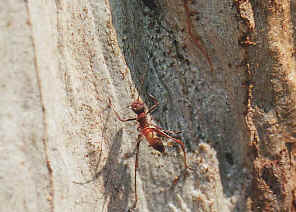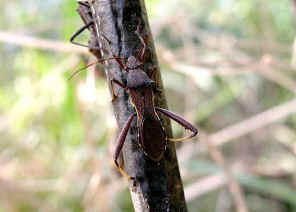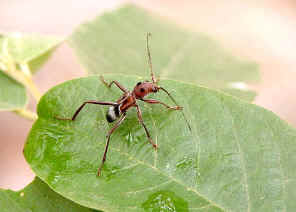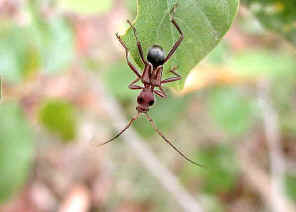|
| |
Ants Mimicry - Myrmecomorphy
- Myrmecomorphy are arthropods that have evolved a morphological resemblance
to ants.
-
 - Ants - the
model of Ants Mimicry
-
-
Ants
are the most abundant group of insects and have powerful defense mechanisms such as acid
taste, aggressive biting, painful sting, and group defense. Ants are generally
not subject to predation. They are the ideal models in mimicry rings. Many insects
and spiders have
different ways to resemble ants. This is known as Myrmecomorphy.
Myrmecomorphy highlights
an
important
aspect of
mimicry
-
the
behavior. Predators
use
different
aspects of
prey appearance when making a decision
to
attack.
Behavior is an important part of
multi-modal signals. Constant waving of antennae
is
a
common feature of
ants.
Ants are
also
characterized by
their
jerky
and
zigzag movements.
Those
ants
behaviour
are
commonly
seen
in
the
ant
mimics.
-
- Followings are the examples that we found in the Ants Mimicry Rings. ALL
of them are NOT ants.
-
- Ant-mimicking
Jumping
Spiders
-
Family
Salticidae

 - Jumping
Spider,
Salticidae,
is
a
very
large
family
contains
the
most
colourful
species
of
spiders.
The
Myrmarachne
genus
mimic
ants.
Besides
the
colours
and
body
shape,
those
spiders'
behaviour
likes
an
ant
too.
They
continuously
waving their front
legs
as
ants
waving
their
antenna.
However,
when
disturbed,
the
spiders
ran
very
fast
and
jumped
as
a
typical
Jumping
Spider.
We
also
noticed
that
those
jumping
spiders
did
not
interact
with
its
ant
model,
i.e.,
did
not
prey
on
foraging
ants.
They
may
simply
gain
protection
by
mimicking
the locally abundant ant species.
Click
here
on
details
about
Ant-mimicking
Jumping
Spiders.
-
-
- Ant-mimic
Lynx Spider - Family Oxyopidae

 - We
saw
this
spider
once
in
Alexander
Hill.
It
was
hunting
on
a
small
Acacia
tree,
where
ants
with
similar
shape
and
colour
can
also
be
found.
When
hunting,
the
spider
walk
like
an
ant.
When
disturbed,
it
ran
much
faster
than
an
ant.
We
observed
that
this
spider
was
actively
interact
with
ants
near
by.
They
may
mimic ants as a trick to approach and prey on
its
ant
model
,
i.e.,
aggressive mimicry.
We
need
more
observations
to
confirm
this.
-
-
- Ant-mimicry
in Katydid nymph - Family Tettigoniidae

 - We will never guess they are the first instars of the Katydids until we saw
their development. They are dark brown and some are black in colour. They are
quite large, about 10mm in body length. They just look like large black ants.
This is an advantage to the young instars for most predators will avoid armed
ants. They have very long antennae, about four times their body length. They
are very active, running and jumping between plants. Details please click on here.
-
-
- Ant-mimicry
in Assassin Bug nymph - Family Reduviidae

 - Quite
a
number
of
bug1st
instars,
order
Hemiptera,
resemble
ants,
including
this
Assassin
Bug.
When
hatched
from
eggs,
those
young
bugs
stay
together,
look
like
a
group
of
ants
which
most
predators
will
avoid.
-
-
- Ant-mimicry
in Coreid Bug nymph - Family Coreidae

 - Coreid
Bug
1st
Instars
also
mimic
ants
to
gain
protections.
They
have
a
pair
of
long
antennae
and
three
pair
of
long
legs.
Their
heads
are
black,
thoraxes
are
yellow
and
abdomens
are
red.
They
stay
together
for
a
few
days.
At
this
stage,
they
look
like
ants.
-
-
- Ant-mimic
Bug - Family Lygaeidae

 - Yes, this is a true bug, Hemiptera. Its body colour and behaviour is mimicking the
black ant. It was found wandering on a large gum tree trunk, where a lot of black ants is
running around. It did not have the waist, which is the characteristic of all
ants, but its body colour pattern mimics just exactly this.
-
-
- Ant-mimic
Bug Nymph - Pod-sucking Bug

 - The adult Pod-Sucking Bugs and different stages of instars on the Easter
Cassia (Senna pendula) cylindrical seedpods. The small Pod-Sucking Bug
nymph mimics black ants.
-
-
- Ant-mimicking Longicorn Beetle

 - ? Ochrya sp. body length 20mm
- We saw this Ant-mimicking Longicorn Beetle once in Karawatha Forest during
early summer. It was a cloudy day. The beetle was resting on a leaf until we
disturbed it. It then slowing walked away. The patterns on the beetle's
back made the beetle looked like a large black ant, with eyes on large head,
narrow waist and round abdomen.
[ Up ] [ Warnings ] [ Ants Mimicry ] [ Wasps Mimicry ] [ Black Wasps Mimicry ] [ Bees Mimicry ] [ Lycid Mimicry ] [ Jumping Spider Mimicry ] [ Self Mimicry ] [ Bird-dropping Mimicking ] [ Behaviour Mimicry ] [ Threaten Sign ] [ Mimicry in Butterfly ] [ Camouflage Master ] [ Eyes Pattern ]
|

















